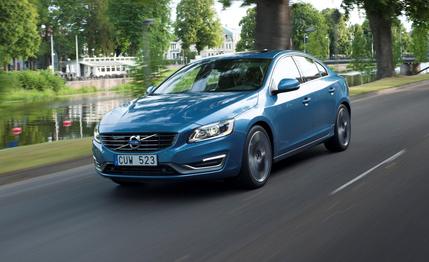 First Drive Review
First Drive Review
Volvo killed its V-8 almost four years ago and now it’s getting out of the five- and six-cylinder engine business, too. Future Volvos will be powered by four-cylinder engines with turbochargers, four-cylinders with turbochargers and belt-driven superchargers, four-cylinders paired with hybrid powertrains, and turbocharged four-cylinders that burn diesel fuel. From roughly the end of next year until internal combustion is criminalized, fours are all Volvo will have. So those fours had better be pretty damn good.
So here’s Volvo’s shot at pretty damn good: a new family of four-cylinder engines—diesels and gas burners built around a common architecture—destined to power every Volvo into the foreseeable future. All that’s riding on them is the company’s viability and what’s left of the Swedish automobile industry.
The first three versions of these 2.0-liter Drive-E engines will go into Volvo’s recently updated S60 sedan, V60 wagon, and XC60 crossover for the 2015 model year. We recently drove 2014 preproduction versions of those models in Euro-spec form in southern France. The gas versions wear familiar T5 and T6 badging, but rest assured they each have only four holes. The S60 was powered by the T5-level mill using a single turbocharger and making 241 horsepower. The XC60 had a 302-hp T6 version featuring a Roots-style blower and a turbocharger. And the V60 got the D4 turbo-diesel rated at 178 horsepower. All three engines are lashed to a new eight-speed automatic transaxle that, in the sampled machines, drives the front wheels (all-wheel drive will be available). A six-speed manual will be offered, but likely not in the U.S.
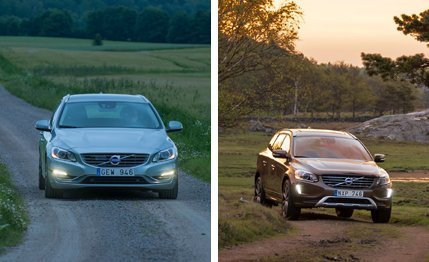 Left: 2014 Volvo V60. Right: Volvo XC60.
Left: 2014 Volvo V60. Right: Volvo XC60.
All the Drive-E engines were designed simultaneously in Sweden; the diesel isn’t, Volvo swears, an Oldsmobile-style conversion of a gas engine. All are based on an aluminum block with iron sleeves with the slightly thicker sleeves in the diesel being made of a different iron alloy to withstand the pressures of a compression-ignition engine. Because all the Drive-E engine blocks are dimensionally similar, they can be machined on the same lines and run through virtually the same assembly procedures. Of course, the cylinder heads for the gasoline and diesel variants are different, but there’s a lot of shared DNA.
The Drive-Es will be built at Volvo’s engine plant in the picturesque and ancient town of Skövde, Sweden. The engines will be exported to China for use in Volvos assembled there, but Volvo says there are no plans at this point for the engines to be used in Geely-branded vehicles built by Volvo’s Chinese owner of the same name.
There’s nothing startling in the Drive-E’s engineering. On the gasoline-fired side, all the current buzzy technologies are aboard. Direct injection feeds each cylinder. The head is a twin-cam design with four valves atop each cylinder, the cams featuring continuously variable valve timing. Down at the bottom of the block are counterrotating balance shafts to keep things running smoothly.
On the diesel side, Volvo claims the new engine incorporates so-called i-Art technology. By electronically monitoring the feedback pressure of each injector, the company explains, the i-Art system continuously adapts the combustion in each of the four cylinders. The goal of this system is closer-to-ideal fuel metering with extremely high fuel-rail pressure (a claimed 36,000 psi).
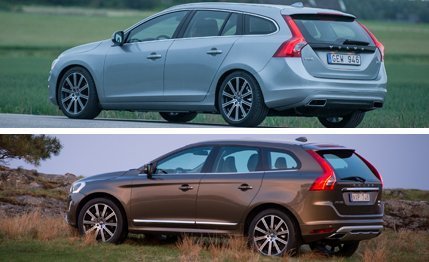 Top: 2014 Volvo V60. Bottom: 2014 Volvo XC60.
Top: 2014 Volvo V60. Bottom: 2014 Volvo XC60.
No matter how many superchargers and turbochargers are bolted to them, the Drive-E engines are of a compact and lightweight design. Volvo says each is about 100 pounds lighter than the comparably rated five- and six-cylinder engines the company has been using. And each version of the Drive-E, Volvo promises, will deliver fuel economy that’s 13 to 25 percent better, too. But like all downsized, forced-induction engines, the proof will be in the real-world-driving pudding.
The 241-hp, single-turbo T5 version installed in the S60 sedan we drove has a wonderfully broad and flat torque curve—Volvo claims 258 lb-ft are available from 1500 to 4800 rpm. Combine that torque-rich character with the relatively short spaces between the eight gears, and the S60 always seems to be operating in the meatiest part of the power band. However, there are only so many thrills that can arise from mixing 241 horsepower with a car that weighs about 3600 pounds.
Volvo claims the S60 equipped with the T5 Drive-E should gallop from 0 to 60 mph in 6.2 seconds. It felt maybe a couple of beats behind that when we drove the hills around Nice. The turbo boosts performance, but it also seems to smother the engine’s exhaust note so that it lacks a definable character. It feels like a lot of other contemporary engines—smooth, unflappable, and tame—so it’s not distinct from most of the competition.
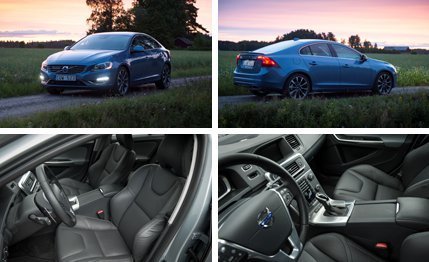 2014 Volvo S60
2014 Volvo S60
As to the S60 itself, it’s still a sweet-natured, comfortable, and antiseptic machine. The 2014 revision includes new sheetmetal for the fenders and hood and new headlights for a more aggressive look. But at its core, the sedan is stoic, only reluctantly communicative, and rarely eager to be pushed harder.
The 302-hp T6-motivated XC60 instantly announces its power with the subdued whine of the belt-driven Eaton supercharger. The goal here, says Volvo, is to use the Eaton to engorge the engine’s output down low and then transition over to a turbocharger as the engine moves to the upper end of its operating range. This results in solid, off-idle thrust and torque that peaks at 295 lb-ft at 2100 rpm and stays there all the way to 4500.
Even the lightest XC60 weighs more than two tons, so that torque production has to push around some mighty mass. Yet the XC60 with the T6 waltzes to 60 mph, Volvo claims, in a reasonable 6.8 seconds. Maybe it’s the sound of that blower, but this crossover feels like it’s hustling when the loud pedal is slapped against the firewall, and it consequently makes the big XC60 a bit more engaging than the T5-powered S60. The XC60’s easygoing, if somewhat remote road manners are appropriate for a big crossover. Volvo has always built fine big boxes, and this is a fine big box.
Finally, we drove the V60 wagon powered by the 178-hp D4 turbo-diesel Drive-E. Whereas the two other engines seem to be working to earn their keep, the diesel almost hums a happy, slightly clattery tune while it runs through the eight gears.
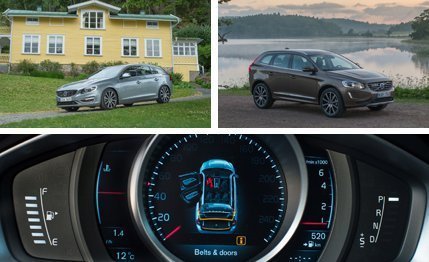 Top left: 2014 Volvo V60. Top right: 2014 Volvo XC60. Bottom: XC60 instrument cluster.
Top left: 2014 Volvo V60. Top right: 2014 Volvo XC60. Bottom: XC60 instrument cluster.
That engine’s happiness stems directly from the diesel’s bountiful torque production. It might only putter out 178 horsepower at 4250 rpm, but it thumps along 295 lb-ft of twist between 1750 and 2500 rpm. Volvo says it will accelerate to 60 mph in 7.5 seconds, but that doesn’t reflect how well behaved the engine was stomping through French traffic.
The mix of the diesel’s personality with the wagon body’s versatility makes this V60 a viable, somewhat-more-upscale alternative to vehicles like the slightly smaller Volkswagen Jetta TDI wagon. The bad news is that Volvo hasn’t yet decided to ship the diesel version of the Drive-E engine over to North America. It should.
Volvo’s four-cylinder-only strategy seems risky looking in from the outside. But simplifying its production this way leads to efficiencies the company needs to remain in the game. After all, Sweden is counting on it.